Stan Tenen is a brilliant researcher (with forty years experience in the Meru Foundation) into "geometric metaphor", which he describes as "... a coherent constellation of geometric models ...[that]... articulates ... that which is held in common by the many spiritual traditions of the ancient world ... as diverse as traditional meditational practices ... and the mathematics fundamental to contemporary biology, physics, and cosmology. These pages are motivated by Stan Tenen's work, and, unless otherwise noted, the illustrations and quotations are from him as source.
Rob Nixon is involved in similar research, in the course of which he has produced much useful data, including the precise order of the 78,064 letters of Genesis, which are used herein.
A web site including the page at www.mechon-mamre.org/p/pt/pt0101.htm has a side-by-side Hebrew-English version of Genesis which is used hereiu. Although the Chapter and Verse structure (and, of course, the English translation) is clearly not something that was part of the original fundamental structure of the Torah, it is something that I (being quite unfamiliar with much of the Hebrew language) need to orient myself within the Torah letter sequence. Even though the English story assigned to the letters is obviously of recent origin, it is possible that some aspects of the story do reflect some ancient meanings associated with letters in the Torah sequence.
A starting point for these pages is my conjectural idea that Perfect Numbers may be one of the keys to understanding the Torah sequence. The Perfect Numbers are numbers that are themselves the sum of their proper factors:
Here are the Torah places of the Perfect Numbers (smaller than 33,550,336):
 that fills all Spaces coming from the Aleph,
that fills all Spaces coming from the Aleph,
which in turn reminds me of the Net of Indra that encompasses All.
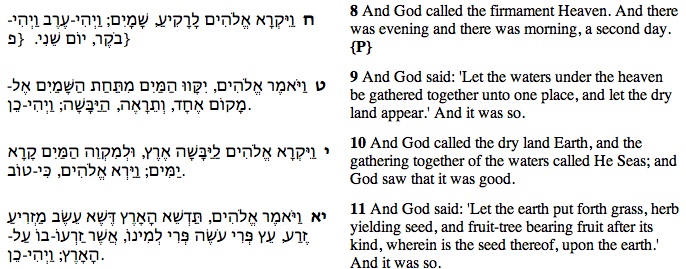
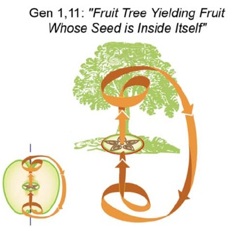
Shin ![]() looks like a Tree of Life that Grows, Multiplies, and Evolves,
branching into new forms.
looks like a Tree of Life that Grows, Multiplies, and Evolves,
branching into new forms.
Perhaps the most extreme Growth in the History of Our Universe was during Inflation, when a huge Quantum Superposition was formed in Inflationary Evolution from the Simple Initial State of Our Universe.
The Evolutionary Growth reminds me of Ganesha (Remover of Obstacles) and his Mice/Seeds.
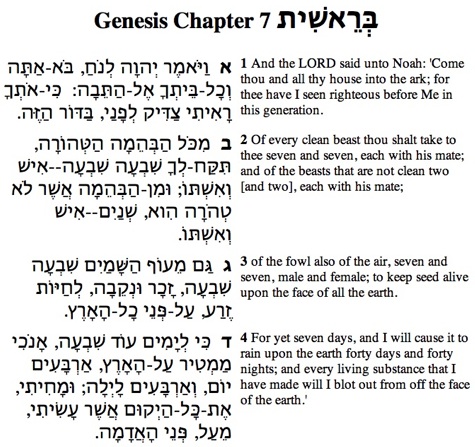
Ayin ![]() has fewer branches than Shin
has fewer branches than Shin ![]() and so represents Pruning some Branches from the Evolutionary Tree of
Life.
and so represents Pruning some Branches from the Evolutionary Tree of
Life.
It also looks like a Fork in the Road of History, whereby Obstacles force Choices.
Perhaps the most extreme Pruning in the History of Our Universe was at the End of Inflation, when a huge Quantum Superposition underwent Decoherence to One Initial State of Ordinary Expansion of Our Universe.
The Pruning reminds me of Shiva, who places Obstacles in the Unfolding Book of History.
Here is some corresponding geometry, beginning with Ain Sof, which is described by Stan Tenen as "... a name that indicates an eternal phase or that which is "before" the beginning of the beginning - before the distinction that made the distinction between the two senses of the infinite. That name is Ain Sof, and it means, simply, without limit: The undifferentiated infinite as such. The Ain Sof is that which exists prior to the very possibility of distinction ...":
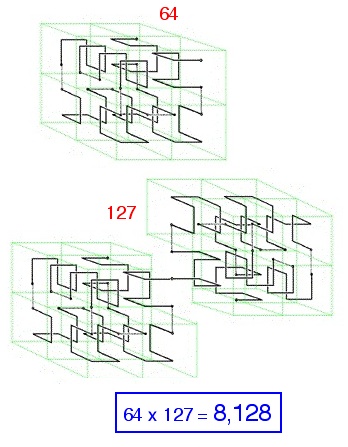
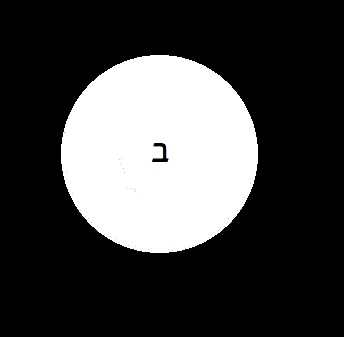
whose 1 First Element Bet ![]() begins
the Inflationary Expanding Network
begins
the Inflationary Expanding Network  of Non-Unitary Octonionic Structure
of Non-Unitary Octonionic Structure
 Expansion in accord with Llullian Clifford Algebra Cl(16) and E8
processes
Expansion in accord with Llullian Clifford Algebra Cl(16) and E8
processes
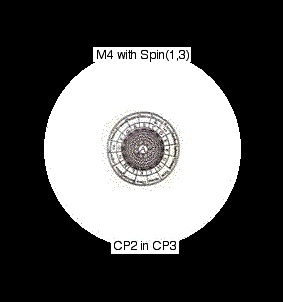
until the End of Inflation when Quaternionic Substructure freezes out forming 8-dimensional Kaluza-Klein spacetime M4 x CP2 in which M4 physical spacetime has local symmetry of 6-dimensional Spin(1,3) and internal symmetry space is CP2 which lives in 6-dimensional CP3.
The 28 letters of the First Verse, when arranged in Stan Tenen's circular patterns

can be seen to describe the Forces of Physics:
the 16 diagonal letters
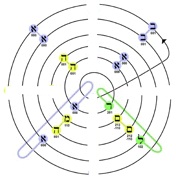
correspond to the 16 elements of U(2,2) which contains the 15-dimensional Conformal Group SU(2,2) = Spin(2,4) which describes Gravity;
the 12 horizontal/vertical letters
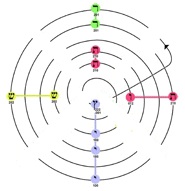
correspond to the 12 elements of the forces of the Standard Model,
where the 4 horizontal
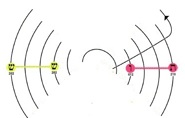
represent the ElectroMagnetic Photon and 3 Weak Force Bosons
and the 8 vertical
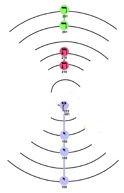
represent the 8 Gluons of the Color Force.
E8 by the McKay correspondence is related to the 3-sphere embedding of the Dodechedron/Icosahedron, whose symmetry group is the 120-element Binary Icosahedral Group (the 120 correpsonds to half of the 240 Root Vectors of E8).
Robion Kirby and Paul Melvin, in their paper "The E8-manifold, singular fibers and handlebody decompositions" (Geometry and Topology Monographs, Volume 2 (1999) pages 233-258), said: "... The E8-manifold is the 4-manifold obtained by plumbing together eight copies of the cotangent disk bundle of the 2-sphere according to the Dynkin diagram for the exceptional Lie group E8 ...
![]()
... The boundary of E8 is the Poincare homology sphere ... Alternatively, E8 may be obtained by taking the p-fold cover of the 4-ball branched over the standard Seifert surface for the (q,r) torus knot (pushed into the interior of B4) where (p, q, r) is a cyclic permutation of (2, 3, 5) ... these four 4-manifolds (E8 and the three branched covers) are diffeomorphic ...".
(The Poincare sphere looks like a dodecahedron - see remarks below for details.) (Knots (p,q) and (q,p) are equivalent.)
Consider one E8 (248 of the 496) as the 2-fold cover of the Seifert surface of the (3,5) torus knot (using Mathematica notation)
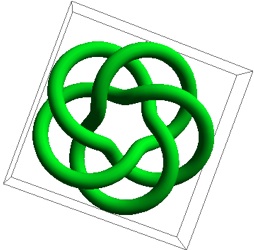
whose braid is

Consider a second E8 (the other 248 of the 496) with the same braid (but changing colors purple to green, green to red, and red to purple)

and join the two E8 braids together

to get the braid

for the (3,10) torus knot (using Mathematica notation)
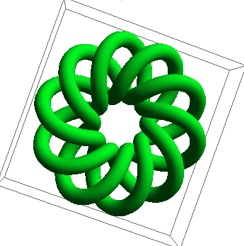
that represents the 496 of the two E8 combined.
Start with the 7 imaginary octonions i, j, k, E, I, J, K. This includes 1, since ii = jj = ... = -1.
You have 2^7 = 128 sign changes. Of the 128 sign changes, the 2^3 = 8 changes of i, j, and E do NOT give a different multiplication.
You have 7! = 2x3x4x5x6x7 permutation changes. Of the 7! permutation changes, those preserving the group PSL(2,7) = SL(3,2) do NOT give a different multiplication. The order of PSL(2,7) is 2^3 x 3 x 7 = 168. It can be thought of as the group of linear fractional transformations of the vertices of a heptagon
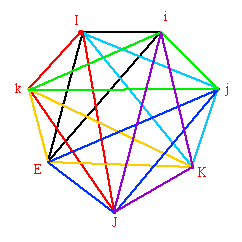
Therefore the number of different multiplications due to sign changes and permutations is:
128 x 2 x 3 x 4 x 5 x 6 x 7 / 8 x 2 x 2 x 2 x 3 x 7 = 16 x 5 x 6 = 480
The symmetry group of the Klein Quartic Curve Equation x ^3 y + y^3 z + z^3 x = 0 is the 168-element group PSL(2,7) = SL(3,2) which Burkland Polster (The Mathematical Intelligencer 21 (1999) 38-43) shows as a 3-dim stereogram of the Fano Plane n which it is formed by the 6 vertices of an octahedron plus its center, with lines being the 3 diagonals of the octahedron plus the 4 circles which circumscribe 4 of the 8 faces of the octahedron. The resulting figure is what Arthur Young calls a heptaverton.
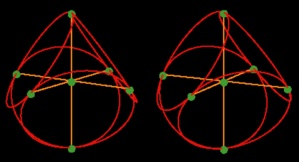
If you include reflections, you get SL(2,7) with 336 elements which is represented by the Klein Configuration shown here as a tiling by 24 heptagons (each heptagon subdivided into 14 triangles) meeting 3 at each vertex
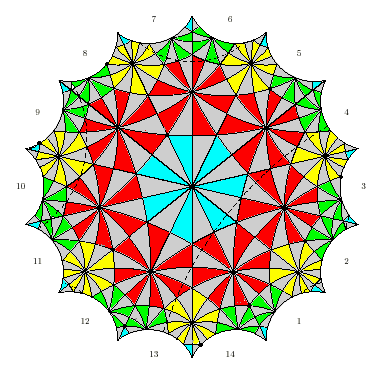
There is a dual tiling by 56 triangles meeting 7 at each vertex
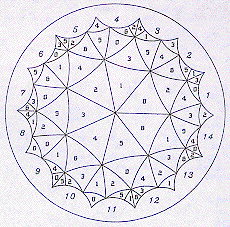
that Greg Egan has illustrated as a 3-hole torus with a 7-coloring and identifying sides 2k+1 and 2k+6 ) (mod 14)
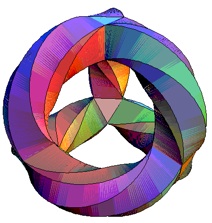
As John Baez noted in his Week 214, in an E8 lattice packing of spheres, "... each one of ... the 240 neighbors of a given sphere ... touches 56 other neighbors ... this gives rise to a 56-dimensional representation of the exceptional group E7 - its smallest nontrivial representation! And ... it gives rise to a 57-dimensional manifold on which the exceptional group E8 acts - the smallest space on which it acts nontrivially! ... if you take Klein's quartic curve tiled by heptagons, and you count the vertices, you get 24 x 7 / 3 = 56 since each vertex is shared by 3 heptagons. ...".

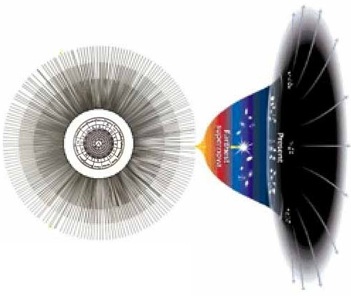
At the End of Inflation 2^64 Superposition States of Our Universe undergo Decoherent Collapse into Many Worlds of the Many-Worlds Quantum Theory, only one of which Worlds is our World.
Cl(K8) = Cl(8) x ... tensor product K times ... x Cl(8),
we have: Cl(64) = Cl(8x8) = Cl(8) x Cl(8) x Cl(8) x Cl(8) x Cl(8) x Cl(8) x Cl(8) x Cl(8)
Therefore, Cl(64) is the first ( lowest dimension ) Clifford algebra at which we can reflexively identify each component Cl(8) with a vector in the Cl(8) vector space. This reflexive identification/reduction causes decoherence. It is the reason that our universe decoheres at N = 2^64 = 10^19.
Ndecoh = 2^64 = 10^19 qubits is just an order of magnitude larger than the number of tubulins Ntub = 10^18 of the human brain. Conscious thought is due to superposition states of those 10^18 tubulins. Since a brain with Ndecoh = 10^19 tubulins would undergo self-decoherence and would therefore not be able to maintain the superposition necessary for thought, it seems that the human brain is about as big as an individual brain can be. The Zizzi Self-Decoherence can be compared to GRW decoherence. Thus the Mind of Man seems to be an image of the Mind of Our Universe.
The ratios of masses of fundamental fermions are determined by E8 Physics in a manner similar to the calculations of Armand Wyler, using the mathematics of Hua Luogeng. Then the Planck mass can be calculated as follows:
There are 8 fermion particles and 8 fermion antiparticles for a total of 64 particle-antiparticle pairs. A typical combination should have several quarks, several antiquarks, a few colorless quark-antiquark pairs that would be equivalent to pions, and some leptons and antileptons. Due to the Pauli exclusion principle, no fermion lepton or quark could be present at the vertex more than twice unless they are in the form of boson pions, colorless first-generation quark-antiquark pairs not subject to the Pauli exclusion principle. Of the 64 particle-antiparticle pairs, 12 are pions. A typical combination should have about 6 pions. If all the pions are independent, the typical combination should have a mass of .14x6 GeV = 0.84 GeV. However, just as the pion mass of .14 GeV is less than the sum of the masses of a quark and an antiquark, pairs of oppositely charged pions may form a bound state of less mass than the sum of two pion masses. If such a bound state of oppositely charged pions has a mass as small as .1 GeV, and if the typical combination has one such pair and 4 other pions, then the typical combination should have a mass in the range of 0.66 GeV. Summing over all 2^64 combinations, the total mass of a one-vertex universe should give mPlanck = 1.217-1.550 x 10^19 GeV.
Each qubit at the end of inflation corresponds to a Planck Mass Black Hole, which undergoes decoherence and, in a process corresponding to Reheating in the Standard Inflationary Model, each qubit transforms into 2^64 = 10^19 elementary first-generation fermion particle-antiparticle pairs.
The resulting 2^64 x 2^64 = 2^128 = 10^19 x 10^19 = 10^38 fermion pairs populating the Universe Immediately After Inflation constitutes a Zizzi Quantum Register of order n_reh = 10^38 = 2^128.
Since, as Paola Zizzi says in gr-qc/0007006, ( with some editing by me denoted by [ ] ): "... the quantum register grows with time. ... At time Tn = (n+1) Tplanck the quantum gravity register will consist of (n+1)^2 qubits. [ Let N = (n+1)^2 ] ...", we have the number of qubits at Reheating:
Nreh = ( n_reh )^2 = ( 2^128 )^2 = 2^256 = 10^77
Since each qubit at Reheating should correspond, not to Planck Mass Black Holes, but to fermion particle-antiparticle pairs that average about 0.66 GeV, we have the result that the number of particles in our Universe at Reheating is about 10^77 nucleons.
After Reheating, our Universe enters the Radiation-Dominated Era, and, since there is no continuous creation, particle production stops, so the 10^77 nucleon Baryonic Mass of our Universe has been mostly constant since Reheating, and will continue to be mostly constant until Proton Decay.
The present scale of our Universe is about R(tnow) = 10^28 cm, so that its volume is now about 10^84 cm^3, and its baryon density is now about 10^77 protons / 10^84 cm^3 = 10^(-7) protons/cm^3 = 10^(-7-19-5) gm / cm^3 = 10^(-31) gm / cm^3 = roughly the baryonic mass density of our Universe.
Since the critical density of our Universe is about 10^(-29) gm / cm^3, it is likely that the excess of the critical mass of our Universe over its baryonic mass is due to a cosmological constant as described by Conformal Gravity in the E8 Physics model which gives a ratio of Dark Energy : Dark Matter : Ordinary Matter of 0.753 : 0.202 : 0.045 .
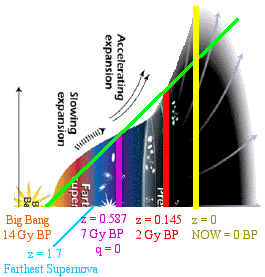
Here are some images from the WWW pages of Richard Hawkins, who calls S3# the Mayan Time Star. His pages contain many more images and movies that help you understand how S3# looks, and also how a lot of other things look.
How did Richard Hawkins find out about the Time Star? Krsanna Duran says: "... I wrote an article about what the Sirians told me about five interpenetrated tetrahedra embodying and unifying all prime geometries which was published in January, 1995. Richard Hawkins read the article and and sent an email to Gerald de Jong about it. Gerald de Jong constructed a computer model of the five interpenetrated tetrahedra to discover that it did all the things I said it did with extraordinary elegance. ...".
Start with a dodedecahedron. Five tetrahedra fit inside the dodecahedron:
The alternating permutation group of the 5 tetrahedra is the 60-element icosahedral group. Now, to see things clearly, look at just one tetrahedron. You can symmetries more clearly when you put an octhedron inside the tetrahedron and a cuboctahedron inside the octahedron:
Take the one tetrahedron and put it inside a cube, with one edge of the tetrahedron in each face of the cube. Now rotate the cube around inside the dodecahedron, while you also rotate each of the 6 edges of the tetrahedron each of the 6 faces of the cube. Start like this:
then, 36 degrees later, it looks like this:
The tetrahedra edges now are parallel to the cube edges. 36 more degrees, after 72 degrees total rotation, the edges will have again formed a tetrahedron. Keep rotating. After 360 degrees, you have made 5 tetrahedra (one each 72 degrees), and this is what you have:
The cube is back like it was, BUT THE TETRAHEDRON IS ORIENTED OPPOSITELY with respect to the cube from its original position. YOU HAVE TO ROTATE 720 degrees TO GET BACK LIKE YOU STARTED. That means that, to make S3#, instead taking the quotient of SO(3) by the 60-element icosahedral group, you should take the quotient of S3 = Spin(3) = SU(2), the double cover of SO(3), by the 120-element binary icosahedral group. Therefore, S3# is a natural spinor space, and 5-fold Golden Ratio Icosahedral Symmetry is a manifestation in 3 and 4 dimensions of the Milnor sphere structure of 7 and 8 dimensions.
Frank Dodd (Tony) Smith, Jr. - 2010